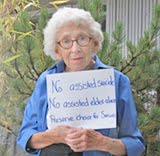There are two states where physician-assisted suicide is legal: Oregon and Washington. In these states, statutes give criminal and civil immunity to doctors
and others, including family members, who participate in a patient's
suicide under certain conditions. Oregon's act
was enacted via a ballot initiative in 1997. Washington's act was
enacted via a ballot initiative in 2008 and went into effect in 2009.
No such law has made it through the scrutiny of a legislature despite more than 100 attempts.
The Oregon and Washington assisted-suicide acts are similar. They apply to "terminal" patients, defined in terms of having less than six months to live. Such persons are not necessarily dying. Consider, for example, Jeanette Hall, now alive 12 years after her terminal diagnosis. More recent proposals to legalize assisted suicide have included people who are clearly not dying. Click here, here and here.
In Montana, Baxter v. State gives doctors who assist a patient's suicide a potential defense to prosecution for homicide. Baxter does not legalize assisted suicide by giving doctors or anyone else immunity from criminal and civil liability although proponents argue that this is the case. Click here and here.
In Montana, the leading group against assisted suicide is Montanans Against Assisted Suicide & For Living with Dignity.
No such law has made it through the scrutiny of a legislature despite more than 100 attempts.
The Oregon and Washington assisted-suicide acts are similar. They apply to "terminal" patients, defined in terms of having less than six months to live. Such persons are not necessarily dying. Consider, for example, Jeanette Hall, now alive 12 years after her terminal diagnosis. More recent proposals to legalize assisted suicide have included people who are clearly not dying. Click here, here and here.
In Montana, Baxter v. State gives doctors who assist a patient's suicide a potential defense to prosecution for homicide. Baxter does not legalize assisted suicide by giving doctors or anyone else immunity from criminal and civil liability although proponents argue that this is the case. Click here and here.
In Montana, the leading group against assisted suicide is Montanans Against Assisted Suicide & For Living with Dignity.
On July 17, 2012, the Minnesota Court of Appeals upheld its law criminalizing assisted suicide as constitutional. To view the court's opinion, click here.
In 2012, Georgia and Louisiana strengthened their laws against assisted suicide. To see Georgia's new statute, click here. To learn more about Louisiana's statute, click here and here.
In July 2011, Idaho enacted a statute strengthening its law against assisted suicide. For more information, click here.
In 2011, bills to legalize physician-assisted suicide were defeated in Montana, Hawaii and New Hampshire. In Vermont, identical legalization bills were introduced in the House and Senate, but not put on for vote before the legislative session ended. In 2012, these same bills died in committee. For more information see Vermont Against Assisted Suicide.
In Hawaii, where a bill to legalize assisted suicide was defeated in 2011 as well as in prior years, proponents claimed that assisted suicide was legal due to a 1909 statute. On December 8, 2011, the Attorney General of Hawaii rejected this claim via a formal legal opinion. See also Hawaii Against Assisted Suicide & For Living with Dignity.
In Connecticut, a lawsuit to legalize physician-assisted suicide was dismissed in 2010. There is now a similar lawsuit pending in New Mexico.
In Massachusetts, there is a pending ballot initiative to enact an Oregon/ Washington style act that applys to "terminal" patients defined as predicted to have less than six months to live. For more information, see Mass Against Assisted Suicide.
Utah has also been targeted by assisted-suicide/euthanasia proponents. See Utah Against Assisted Suicide: "Choice" is an Illusion.




















